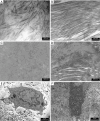The discoid lateral meniscus in children: a narrative review of pathology, diagnosis and treatment
- PMID: 38529145
- PMCID: PMC10929324
- DOI: 10.21037/aoj-21-31
The discoid lateral meniscus in children: a narrative review of pathology, diagnosis and treatment
Abstract
Background and objective: The discoid lateral meniscus (DLM) is a congenital abnormality of the meniscal shape, characterized by a typical central hypertrophy and a diameter larger than a regular meniscus, potentially leading to knee pain and symptoms, especially in children. The present study provides an update and a general review of this uncommon meniscal pathology. The incidence of discoid meniscus is about 0.4-17% for the lateral and 0.1-0.3% for the medial, although, being often asymptomatic, the true prevalence is unknown. We aim to enhance awareness on this subject to medical care provider.
Methods: A literature search was performed on PubMed, including articles written in English until October 2021.
Key content and findings: The articles regarding etiology, diagnosis and management of DLM in children or in patients younger than 18 years were reviewed using the narrative approach.
Conclusions: Recent literature has shown that DLM is one of the most frequent congenital anomalies of the knee encountered during childhood. While asymptomatic children with incidental finding can be managed nonoperatively, symptomatic painful DLM should be addressed surgically, restoring typical anatomy using saucerization, tear repair, and stable fixation of the meniscus. The risk of osteoarthritis progression seems to be higher in children with operated DLM, imposing prolonged follow-up and cartilage preserving strategies for these patients.
Keywords: Knee; children; discoid lateral meniscus (DLM); meniscus; saucerization.
2022 Annals of Joint. All rights reserved.
Conflict of interest statement
Conflicts of Interest: All authors have completed the ICMJE uniform disclosure form (available at https://aoj.amegroups.com/article/view/10.21037/aoj-21-31/coif). The series “The Lateral Meniscus” was commissioned by the editorial office without any funding or sponsorship. AG served as the unpaid Guest Editor of the series. SZ served as the unpaid Guest Editor of the series and serves as an unpaid editorial board member of Annals of Joint from March 2021 to February 2023. The authors have no other conflicts of interest to declare.
Figures







Similar articles
-
Factors associated with bilateral discoid lateral meniscus tear in patients with symptomatic discoid lateral meniscus tear using MRI and X-ray.Orthop Traumatol Surg Res. 2019 Nov;105(7):1389-1394. doi: 10.1016/j.otsr.2019.08.007. Epub 2019 Oct 10. Orthop Traumatol Surg Res. 2019. PMID: 31607576
-
Arthroscopic Treatment of Symptomatic Discoid Lateral Meniscus and Nondiscoid Meniscus in Adolescent Patients.Am J Sports Med. 2022 Dec;50(14):3805-3811. doi: 10.1177/03635465221130455. Epub 2022 Nov 7. Am J Sports Med. 2022. PMID: 36342468
-
Radial Width of the Lateral Meniscus at the Popliteal Hiatus: Relevance to Saucerization of Discoid Lateral Menisci.Am J Sports Med. 2022 Jan;50(1):138-141. doi: 10.1177/03635465211056661. Epub 2021 Nov 15. Am J Sports Med. 2022. PMID: 34780308
-
Discoid lateral meniscus: evaluation and treatment.Am J Orthop (Belle Mead NJ). 2004 May;33(5):234-8. Am J Orthop (Belle Mead NJ). 2004. PMID: 15195915 Review.
-
Discoid lateral meniscus: current concepts.J ISAKOS. 2021 Jan;6(1):14-21. doi: 10.1136/jisakos-2017-000162. Epub 2020 Sep 16. J ISAKOS. 2021. PMID: 33833041 Review.
Cited by
-
Diagnostic Efficiency of MRI in Child and Adolescent Lateral Discoid Meniscus.Orthop Surg. 2025 Mar;17(3):900-908. doi: 10.1111/os.14357. Epub 2025 Feb 9. Orthop Surg. 2025. PMID: 39924921 Free PMC article.
-
Discoid meniscus: Treatment considerations and updates.World J Orthop. 2024 Jun 18;15(6):520-528. doi: 10.5312/wjo.v15.i6.520. eCollection 2024 Jun 18. World J Orthop. 2024. PMID: 38947261 Free PMC article. Review.
References
-
- Young R. The external semilunar cartilage as a complete disc. In: Cleland J, Macke J, Young R. editors. Memoirs and Memoranda in Anatomy. London: Williams and Norgate, 1887:179-87.
-
- SMILLIE IS . The congenital discoid meniscus. J Bone Joint Surg Br 1948;30B:671-82. - PubMed
Publication types
LinkOut - more resources
Full Text Sources
